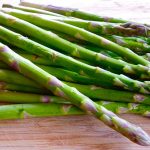 The word asparagus derives from two Greek words: ana, meaning up, and spargan, meaning to swell, a reference to the prominent shoots of the plant that “swell up” as it grows. Oddly, the word was used in English at the beginning of the eleventh century but then vanished until the middle of the sixteenth century, when it reappeared as sperage. By the beginning of the seventeenth century, books written by scholars and herbalists had made the Latin name of the vegetable, asparagus, familiar to the common people, but within another fifty years these same common folk had changed asparagus—which to them was an odd-sounding foreign word—into something that seemed more “English”: sparrow-grass, a comforting but nonsensical name, especially considering that sparrows eat only seeds and insects. From the mid seventeenth to the mid nineteenth century sparrow-grass remained the usual name of the plant, but eventually the Latin form asparagus was reintroduced and reaccepted as “proper.” The proper plural of asparagus, given its Latin form, is asparagi, just as the plural of alumnus is alumni.
The word asparagus derives from two Greek words: ana, meaning up, and spargan, meaning to swell, a reference to the prominent shoots of the plant that “swell up” as it grows. Oddly, the word was used in English at the beginning of the eleventh century but then vanished until the middle of the sixteenth century, when it reappeared as sperage. By the beginning of the seventeenth century, books written by scholars and herbalists had made the Latin name of the vegetable, asparagus, familiar to the common people, but within another fifty years these same common folk had changed asparagus—which to them was an odd-sounding foreign word—into something that seemed more “English”: sparrow-grass, a comforting but nonsensical name, especially considering that sparrows eat only seeds and insects. From the mid seventeenth to the mid nineteenth century sparrow-grass remained the usual name of the plant, but eventually the Latin form asparagus was reintroduced and reaccepted as “proper.” The proper plural of asparagus, given its Latin form, is asparagi, just as the plural of alumnus is alumni.
A genus of liliaceous herbs. It is a green cylindrical vegetable that contains carotenoids, vitamins C and K, and fiber.
Asparagus is a cultivated plant that belongs to the lily family, although it originally grew near the seashore. This vegetable has been popular for centuries and is available in many varieties, including some that are pale green, almost white, and others with purple tips. In the United States, green asparagus grown outdoors is in season from April until the end of June. Although asparagus has relatively low nutritional value, it is highly prized for its delicious flavor and versatility in a variety of culinary preparations. To extend its relatively brief growing season, asparagus may be jarred or frozen, and it is also available in canned form. Asparagus makes an excellent soup and both canned and packaged soup preparations are readily available for those who enjoy this classic dish.
